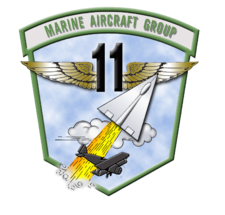
Marine Fighter Attack Squadron 232 (VMFA-232) is a United States Marine Corps F/A-18 Hornet squadron. Nicknamed the "Red Devils", the squadron is based at Marine Corps Air Station Miramar, California and falls under the command of Marine Aircraft Group 11 (MAG-11) and the 3rd Marine Aircraft Wing. The Red Devils are the oldest and most decorated fighter squadron in the Marine Corps.
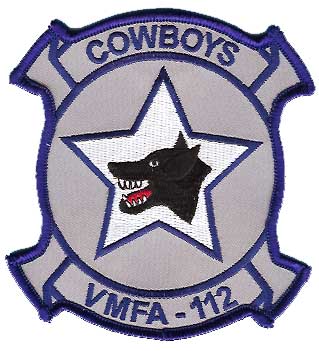
Marine Fighter Attack Squadron 112 (VMFA-112) is a reserve United States Marine Corps McDonnell-Douglas F/A-18 Hornet squadron. The squadron is based at NASJRB Fort Worth, Texas and falls under the command of Marine Aircraft Group 41 (MAG-41), 4th Marine Aircraft Wing. Their tail code is MA. During World War II the squadron saw extensive action throughout the Pacific Theater of Operations especially at the Battle of Guadalcanal as part of the Cactus Air Force. By the end of the war, its 140 air-to-air kills ranked it third among Marine Corps squadrons.

Marine Fighter Attack Squadron 323 (VMFA-323) is an aircraft carrier-based aviation squadron of the United States Marine Corps. The squadron is equipped with the McDonnell Douglas F/A-18C Hornet and is based at Marine Corps Air Station Miramar, California, United States. It falls under the command of Marine Aircraft Group 11 (MAG-11) and the 3rd Marine Aircraft Wing but deploys with the U.S. Navy's Carrier Air Wing 17 (CVW-17). Their tail code is WS and their radio callsign is Snake.

Marine Fighter Attack Squadron 122 (VMFA-122) is a United States Marine Corps fighter attack squadron flying the F-35B Lightning II. The squadron is based out of Marine Corps Air Station Yuma, AZ and falls under the command of Marine Aircraft Group 13 (MAG-13) and the 3rd Marine Aircraft Wing. The squadron nickname is the "Flying Leathernecks," and their traditional radio call sign is "Nikel". On 14 November 2017, VMFA-122 opened a new chapter of their history, transitioning from the McDonnell Douglas F/A-18C Hornet to the Lockheed Martin F-35B Lightning II and moving from MCAS Beaufort and MAG-31, 2nd MAW to MCAS Yuma and MAG-13, 3rd MAW.

Marine Fighter Attack Squadron 211 (VMFA-211) is a United States Marine Corps fighter attack squadron, currently consisting of F-35B Lightning II stealth STOVL strike fighter jets. Known as the "Wake Island Avengers" and the "Bastion Defenders", the squadron is based at Marine Corps Air Station Yuma, Arizona and falls under the command of Marine Aircraft Group 13 (MAG-13) and the 3rd Marine Aircraft Wing.

Marine Fighter Attack Squadron 311 (VMFA-311) is a United States Marine Corps fighter attack squadron consisting of F-35C Lightning II. Known as the "Tomcats", the squadron is based at Marine Corps Air Station Miramar, California and falls under the command of Marine Aircraft Group 11 (MAG-11) and the 3rd Marine Aircraft Wing.

The 3rd Marine Aircraft Wing is the major west coast aviation unit of the United States Marine Corps. It is headquartered at Marine Corps Air Station Miramar, in San Diego, California and provides the aviation combat element for I Marine Expeditionary Force. The wing is made up of a headquarters squadron, four flying groups, an aviation command and control group and an aviation engineering group.
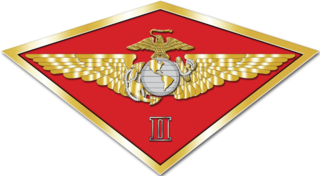
The 2nd Marine Aircraft Wing is the major east coast aviation unit of the United States Marine Corps and is headquartered in Marine Corps Air Station Cherry Point, North Carolina. The Wing provides the aviation combat element for the II Marine Expeditionary Force.
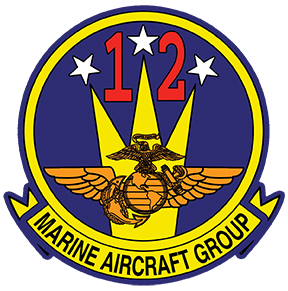
Marine Aircraft Group 12 (MAG-12) is an active air group of the United States Marine Corps, tasked with providing fighter and assault support aircraft. It is currently part of the 1st Marine Aircraft Wing, itself an integral part of the III Marine Expeditionary Force, and based at MCAS Iwakuni in Japan.

Marine Fighter Attack Squadron 115 (VMFA-115) was a United States Marine Corps F/A-18 Hornet squadron. Officially nicknamed the "Silver Eagles" and on occasion Joe's Jokers after their first commanding officer Major Joe Foss, the squadron was last based at Marine Corps Air Station Beaufort, South Carolina and fell under the command of Marine Aircraft Group 31 (MAG-31) and the 2nd Marine Aircraft Wing. The squadron participated in combat operations during World War II, the Korean and Vietnam Wars and has deployed in support of Operation Iraqi Freedom with a final deployment in 2008 to Al Asad Airbase in western Iraq. The Squadron radio callsign was "Blade".

Marine Fighter Attack Squadron 142 (VMFA-142) was an aviation unit of the United States Marine Corps Reserve that was active from 1942 to 2008. At the time of its inactivation, the squadron was based at Naval Air Station Atlanta, Georgia and fell under the command of Marine Aircraft Group 42 (MAG-42), 4th Marine Aircraft Wing. Due to a re-organization within Marine aviation, the squadron moved to Naval Air Station Fort Worth Joint Reserve Base, Texas and was placed in a cadre status under Marine Aircraft Group 41.
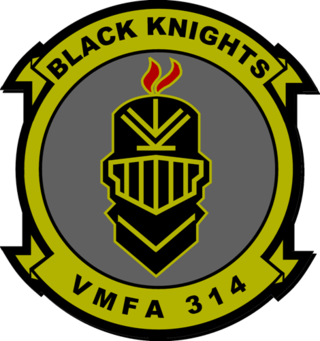
Marine Fighter Attack Squadron 314 (VMFA-314) is a United States Marine Corps F-35C Lightning II squadron. The squadron, known as the "Black Knights", is based at Marine Corps Air Station Miramar, California and falls under the command of Marine Aircraft Group 11 (MAG-11) and the 3rd Marine Aircraft Wing, but deploys with the US Navy's Carrier Air Wing Nine (NG).
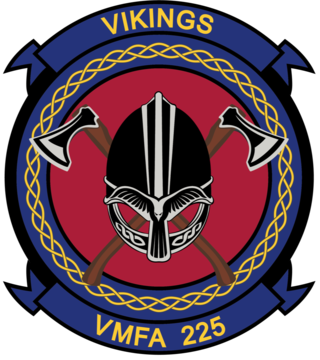
Marine Fighter Attack Squadron 225 (VMFA-225) is a United States Marine Corps fighter attack squadron flying the F-35B Lightning II. The squadron, known as the "Vikings", is based at Marine Corps Air Station Yuma in Arizona and falls under the command of Marine Aircraft Group 13 (MAG-13) and the 3rd Marine Aircraft Wing.
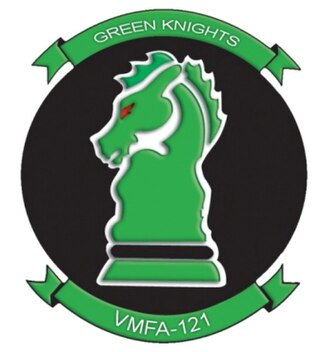
Marine Fighter Attack Squadron 121 (VMFA-121), also known as the "Green Knights", is a United States Marine Corps aircraft squadron operating the F-35B Lightning II. The squadron is based at Marine Corps Air Station Iwakuni, Japan and falls under the command of Marine Aircraft Group 12 (MAG-12) and the 1st Marine Aircraft Wing. Their tail code is VK and their radio call sign is "Combat".

Marine Aircraft Group 13 is a United States Marine Corps aviation unit based at Marine Corps Air Station Yuma that is currently composed of one McDonnell Douglas AV-8B Harrier II squadron, three Lockheed Martin F-35B Lightning II squadrons, an unmanned aerial vehicle squadron, a maintenance and logistics squadron, and a wing support squadron. The group falls under the command of the 3rd Marine Aircraft Wing and the I Marine Expeditionary Force.

Marine Fighter Attack Squadron 312 (VMFA-312) is a United States Marine Corps F/A-18C Hornet squadron. Also known as the "Checkerboards", the squadron is based at Marine Corps Air Station Beaufort, South Carolina and falls under the command of Marine Aircraft Group 31 (MAG-31) and the 2nd Marine Aircraft Wing. The Radio Callsign is "Check."

Marine Aircraft Group 41 (MAG-41) is a United States Marine Corps reserve aviation unit based at Naval Air Station Joint Reserve Base Fort Worth, Texas that is currently composed of one F/A-18C squadron, one KC-130J squadron, one C-40 squadron, one Northrop F-5 aggressor squadron based at Marine Corps Air Station Yuma, Arizona, one Marine Light Attack Helicopter Squadron at MCAS Camp Pendleton, one MV-22B squadron based at MCAS Miramar, one aviation logistics squadron and two wing support squadrons with multiple detachments throughout the United States.

Marine Fighter Attack Squadron 242 (VMFA-242) is a United States Marine Corps squadron flying F-35B Lightning II STOVL Stealth Fighter. The squadron, known as the "Bats", is based at Marine Corps Air Station Iwakuni, Japan and falls under the command of Marine Aircraft Group 12 (MAG-12) and the 1st Marine Aircraft Wing. The radio callsign is "Profane".

Marine Wing Communications Squadron 28 (MWCS-28) is a United States Marine Corps communications squadron. The squadron provides expeditionary communications for the aviation combat element of the II Marine Expeditionary Force. They are based at Marine Corps Air Station Cherry Point and fall under the command of Marine Air Control Group 28 and the 2nd Marine Aircraft Wing.

The United States Marine Corps Aviation (USMCA) is the aircraft arm of the United States Marine Corps. Aviation units within the Marine Corps are assigned to support the Marine Air-Ground Task Force, as the aviation combat element, by providing six functions: assault support, antiair warfare, close air support, electronic warfare, control of aircraft and missiles, and aerial reconnaissance. The Corps operates rotary-wing, tiltrotor, and fixed-wing aircraft mainly to provide transport and close air support to its ground forces. Other aircraft types are also used in a variety of support and special-purpose roles. All Marine Corps aviation falls under the influence of the Deputy Commandant for Aviation, whose job is to advise the Commandant of the Marine Corps in all matters relating to aviation, especially acquisition of new assets, conversions of current aircraft, maintenance, operation, and command.
